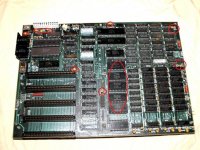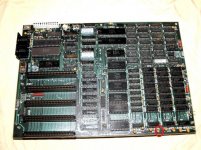PCFreek
Experienced Member
Hi guys... it's been a while. I just pulled all of my collection out and am getting back into this. Funny how much I have forgotten and had to re-learn after taking time away.
I have a 5150 with a 16 to 64kb MB that will not power up. Swapped in a known good later model power supply and the fan will not turn when it is powered up. I have verified that the 3rd pin from the edge of the MB in P8 (+12v) is 0.2ohm to ground. -12v is not grounded. The power supply fan spins with P8 removed and P9 still installed. I have removed one leg of just about every tantalum capacitor on the board.... only the ones below the parity chip in the RAM area remain. I have also removed all cards and all ROMs. I have not removed the RAM.
The attached image is not the MB that I am working on, but the red circles indicate what I have removed thus far. I am not attempting to power it up in this state... I am simply testing resistance between pin 3 on plug P8 and ground and still get little resistance. The tantalums that I have lifted a leg on all test good (ohms increase to infinite or extremely high when checked for resistance).
Any ideas? Troubleshooting that I find online doesn't seem to go past tantalums. Thanks!

I have a 5150 with a 16 to 64kb MB that will not power up. Swapped in a known good later model power supply and the fan will not turn when it is powered up. I have verified that the 3rd pin from the edge of the MB in P8 (+12v) is 0.2ohm to ground. -12v is not grounded. The power supply fan spins with P8 removed and P9 still installed. I have removed one leg of just about every tantalum capacitor on the board.... only the ones below the parity chip in the RAM area remain. I have also removed all cards and all ROMs. I have not removed the RAM.
The attached image is not the MB that I am working on, but the red circles indicate what I have removed thus far. I am not attempting to power it up in this state... I am simply testing resistance between pin 3 on plug P8 and ground and still get little resistance. The tantalums that I have lifted a leg on all test good (ohms increase to infinite or extremely high when checked for resistance).
Any ideas? Troubleshooting that I find online doesn't seem to go past tantalums. Thanks!

Last edited:

